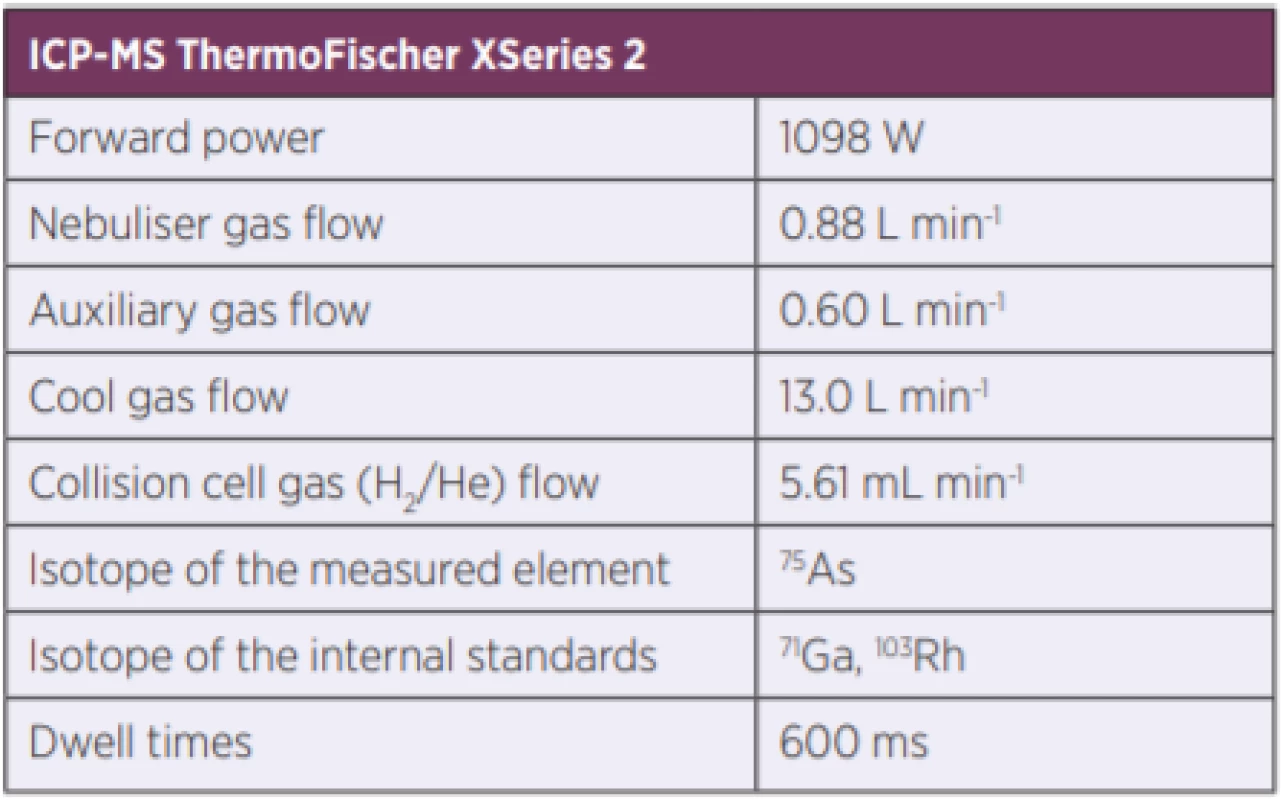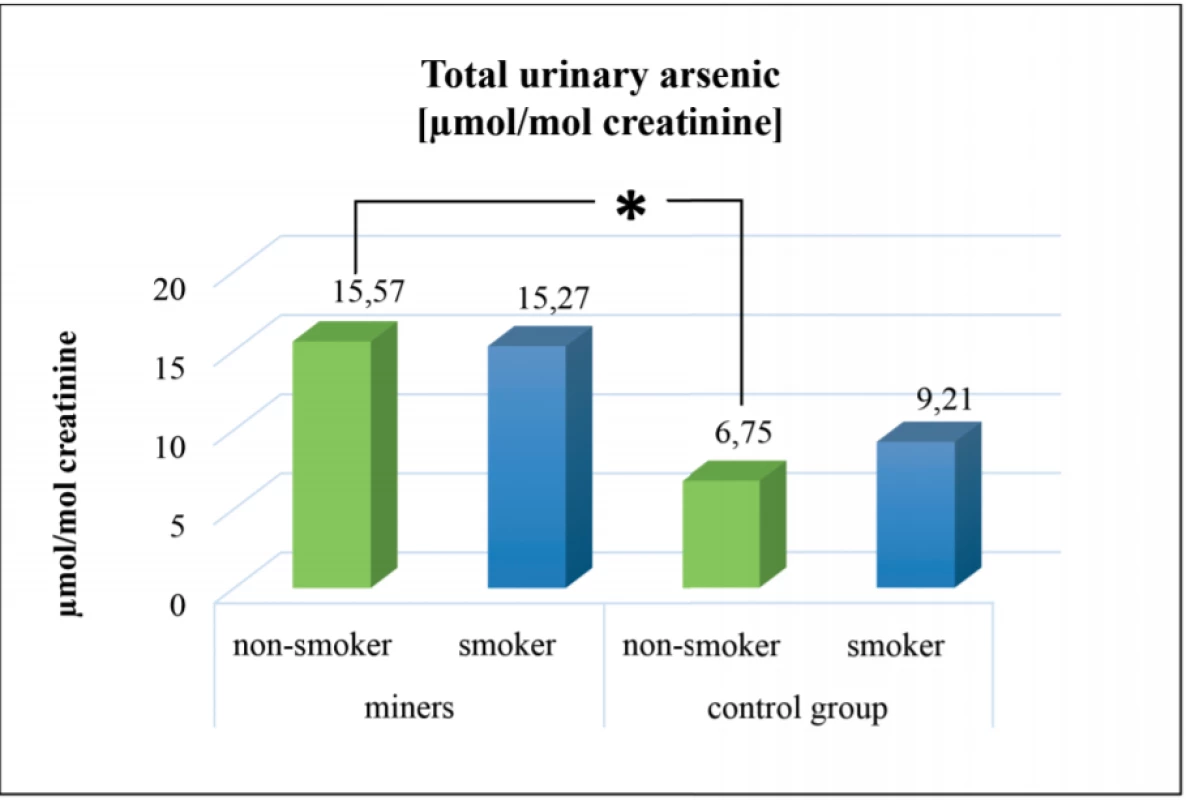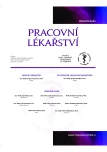The exposure to arsenic in mining professions
Authors:
V. Ferenčíková; M. Mikolajčíková; G. Hubená; K. Fiolková; V. Sokolíková; O. Osina
Authors‘ workplace:
Univerzita Komenského v Bratislave, Jesseniova lekárska fakulta v Martine,
Univerzitná nemocnica Martin, Klinika pracovného lekárstva a toxikológie, vedúci pracoviska doc. MUDr. Oto Osina, PhD.
Published in:
Pracov. Lék., 71, 2019, No. 3-4, s. 62-67.
Category:
Original Papers
Overview
The mining professions are one of the most physically demanding jobs. Into the group of mining professions we can include mining maintenance man, mine equipment operators, mine electricians, longwall move operators and other. The mining industry in region Horná Nitra is oriented mainly on mining and processing of brown coal. Arsenic (As) occurs in brown coal in auripigment and realgar. From the toxicological point of view, it is important to focus on arsenic. According to the International Agency for Research on Cancer arsenic is a human carcinogen of Group I. Arsenic in the human body can be monitored by the most sensitive technique the Inductively coupled plasma with Mass spectrometry.
The group consisted of 23 miners (smoker, non-smoker) from a brown coal mine and 21 people (smoker, non-smoker) without exposure to arsenic from their workplace or environment. The group of miners was divided according to the type of mining profession. The biological material was analyzed by Inductively coupled plasma with Mass spectrometry ThermoFischer XSeries 2. The measured isotope was 75As.
The total blood and urinary arsenic concentrations were not higher than the biological limit value. What could be due to the fact that the analysis of total arsenic was done a few days after finishing the work in the mine. However, statistically significant higher total arsenic concentration was found in the non-smokers miners compared with the non-smokers control group (p-value < 0.005). By focusing on the mining professions, total urine arsenic concentrations were higher in the mining professions compared with the control group. For this reason, we should not forget the mining professions and regular biological exposure tests for arsenic in miners.
Keywords:
arsenic – brown coal – mining profession
INTRODUCTION
The mining professions are one of the most physically demanding jobs. Miners are working in difficult microclimatic conditions such as excessive heat, cold, humidity, and in the presence of dust, noise and vibration. They operate in forced positions with excessive physical load. These negative factors contribute to the overall morbidity of miners with a dominance of diseases of limbs from long-term, inordinate, one-sided workload and respiratory system disorders [1, 2]. Among the mining professions, we include mining breakers, mine equipment operators, drillers, longwall move operators and many others [3]. There is a presumption that exposure to arsenic varies according to the type of their profession. The role of miners in Slovak Republic, since the beginning of the 18th century, is mainly the mining of energy important, brown coal. The largest producer of brown coal is Hornonitrianske mine Prievidza (HMP) and it consists of the mines; Handlová, Nováky and Čáry [4]. In 2018, approximately 4,000 people worked in the company HMP [5].
Brown coal, which is used as the solid fuel to produce electricity or for heating, is formed from plant and animal residues. It consists primarily of 50–70% carbon, and other toxicologically relevant substances such as arsenic, silicon dioxide, sulphur, nitrogen, hydrogen, calcium, iron, manganese, mercury, cadmium etc. [6]. Arsenic occurs in brown coal in auripigment and realgar. The brown coal from the Handlová contains 920–1530 ppm of arsenic. Compared with other deposits in Slovak Republic, this value is ten times higher [2, 7]. From a toxicological point of view, it is important to focus on arsenic (As). According to the International Agency for Research on Cancer (IARC), arsenic is a human carcinogen of Group I. After multiple years of inhalation and oral exposure to arsenic, carcinomas may develop (e.g., carcinomas of liver, lung, kidney, bladder, skin) [8, 9, 10]. Biological Limit Value (BLV) in the Slovak Republic for total urinary arsenic is 116.00 µmol/mol creatinine and for total blood arsenic is 0.307 μmol/l [10].
Arsenic exposure in human body can be monitored with the most widely used technique; the Inductively coupled plasma with Mass spectrometry (ICP-MS). In the analytical chemistry, it is the most sensitive, ultra-trace technique [11]. The ICP-MS operates with a very low detection limit (ppt, pg/g), which allows for the determination of direct samples at low concentrations. The advantages of the ICP-MS are wide linear dynamic range and precision. The disadvantages of the ICP-MS are polyatomic interferences and matrix effect from samples with complex matrix (e.g., biological material – blood, urine, serum, nails, etc.) [12, 13]. But recent research improved the possibilities for reducing polyatomic interferences by using a reaction or collision cell. It increases the functionality, accuracy and reliability of analytical machine [14].
The aim of our work was quantify by the ICP-MS, the total blood arsenic and total urinary arsenic concentrations in the group of miners from the Hornonitrianske mine Prievidza, compared with people without exposure. Next was to focus on total arsenic in the mining professions they were done in the mine compared with the control group.
METHODS
Firstly, group of miners were informed about the project aims. It consisted of 23 miners with different types of mining profession. They were divided to the non-smoker group (n = 11) and smoker group (n = 12). By completing the questionnaire, were gained the necessary information about their personal and occupational history. After a signature of informed consent by the miner, was obtained the biological material (heparin blood, morning urine). Urine creatinine determination was performed by the spectrophotometric method (Jaffe reaction) then biological material was frozen (-18 °C). The same procedure was completed for the 21 men (control group) without exposure to arsenic from their workplace or environment. They were divided to the non-smoker group (n = 11) and smoker group (n = 10) (tab. 1).

Everyone of this study was hospitalized at the Clinic of Occupational Medicine and Toxicology, University Hospital in Martin (COMaT, UHM). The miners were from Hornonitrianske mine Prievidza (HMP) and they came at COMaT, UHM few days after finishing the work in the mine (5.2 ± 1.6 days).
The total arsenic concentration in the biological material (heparin blood and morning urine) was determined by ICP-MS ThermoFischer XSeries 2. The ICP-MS setting conditions are displayed in table 2. The Forward power, nebuliser gas flow, auxiliary gas flow, cool gas flow have been set in CCT mode. For arsenic determinations in biological material have to be used collision gases (H2, He) to remove the effects of polyatomic interferences. The measured isotope was 75As, and as an internal standard were used 71Ga, 103Rh.

The Inductively coupled plasma with Mass spectrometry was verified by the Internal Controller: the Performance Report and by calibration curve (0,5; 1; 2; 5; 10; 20 µg/l). Finally, it was verified with Certified Reference Material (CRM Blood SeronormTM and CRM Urine SeronormTM) and then was prepared for the determination of total arsenic concentration in biological material.
Before analysis, heparin blood and morning urine were thawed and were diluted with blank (double-distilled water, nitric acid, triton X100, 2-propanol). The blood was diluted 1:39; 150 µl of heparin blood with 5.85 ml of blank. The urine was diluted 1:9; 1 ml morning urine with 9 ml of blank. Diluted samples of biological material were centrifuged (10 minutes, 4000 x g). Subsequently, prepared samples were injected into the Inductively coupled plasma with Mass spectrometry and there were analyzed. Obtained results were statistically evaluated using Microsoft Excel statistical functions (arithmetic mean, standard deviation, Studentov t-test).
RESULTS
The obtained results from total blood arsenic analysis of the miners were compared with control group and results are shown in table 3. These groups were divided to smoker group and non-smoker group (table 3). There was no significant difference (p-value > 0.05).

The difference between smoker miners and non-smoker miners (total urinary arsenic concentration) was not statistically significant. Statistically significant higher total urinary arsenic concentration was in the group of non-smoker miners compared with non-smoker control group (p-value = 0.0053). The total urinary arsenic concentration within the group of non-smoker miners was 15.57 ± 9.10 µmol/mol creatinine and within the non-smoker control group was 6.75 ± 2.20 µmol/mol creatinine (Figure 1).

Based on the high standard deviation (SD) in each group of miners, study was focused more closely on the work they performed. There were 7 mining maintenance men, 8 mine equipment operators, mine electricians and 8 longwall move operators (Table 4). The total urinary arsenic concentration was higher in the group of longwall move operator (18.65 ± 14.22 μmol/mol creatinin) in compare with control group and other mining professions. But there was no significant difference (p-value > 0.05).

DISCUSSION
The mining profession is associated with exposure to arsenic, which is one of the components of brown coal. According to the IARC, arsenic is classified as a human carcinogen of Group I [2, 7, 8, 10]. Due to negative effect of this element, we focused on the analysis of total blood arsenic and total urinary arsenic in miners by the Inductively coupled plasma with Mass spectrometry.
By analyzing the total blood arsenic within the group of miners and the control group, there was no significant difference. The total blood arsenic concentrations were lower than BVL (10). However, it is important to note that the miners entered the Clinic of occupational medicine and toxicology, few days (5.2 ± 1.6 days) after last working in the mine. This confirms the fact that the half-life of arsenic blood excretion is approximately 4–30 hours, depending on the form in which it occurs. This short half-life of excretion is due to the absence of sulfhydryl groups (SH) to which arsenic could bind in the long term [15]. Thus, in the case of blood analysis, it could not clearly determine whether miners were exposed to carcinogenic arsenic. We recommended that concentrations of arsenic in blood should be monitored directly after work in the mine, to assess the exposure.
The total urinary arsenic concentrations were not higher than Biological Limit Value (10). Results from urine analyzes were variable, as evidenced by higher standard deviation (SD). It was necessary to focus on the group in more detail. Firstly, the group of miners was divided into smokers and non-smokers (tab. 3), as arsenic could be found in cigarettes (16). The difference of total urinary arsenic concentration was not statistically significant (p-value > 0,05) between smoker miners and non-smoker miners. Statistically significant higher total urinary arsenic concentration was in the group of non-smoker miners compared with non-smoker control group (p-value < 0,005). In this case, it could be stated that the miners were significantly exposed to arsenic compared with the control group (see Figure 1).
Secondly, the group of all miners was divided according to the type of work they did in the mine. There was the assumption, the deeper in the mines and more demanding the work would cause the higher total urinary arsenic concentrations. The smallest risk was attributed to the operating mining maintenance men that were underground and their role is the maintenance of mines and mining machines. The higher exposure risk was attributed to the mine equipment operators and mining electricians, who were deeper in the underground and they worked on problems closely related to mining. The most risky group was longwall move operator. It was confirmed by higher total urinary arsenic concentrations within this group, in compared with control group and group of mining maintenance man (see Table 4).
It should be noted that the total urinary arsenic concentrations were variable in the groups (mine equipment operator, mine electrician and longwall move operator) (see Table 4). It could be caused by an insufficient number of miners in the groups; therefore it would be useful to extend it in the future.
CONCLUSION
The mining professions are one of the most physically demanding jobs. The mining industry in region Horná Nitra is oriented mainly on mining of brown coal where Arsenic (As) may occur. We were focused on arsenic because As is a human carcinogen of Group I, according to the International Agency for Research on Cancer.
The total blood and urinary arsenic concentrations were not higher than the biological limit value. What could be due to the fact that the analysis of total arsenic was done a few days after finishing the work in the mine. However, statistically significant higher total arsenic concentration was found in the non-smokers miners compared with the non-smokers control group (p-value < 0.005). By focusing on the mining professions, total urine arsenic concentrations were higher in the mining professions compared with the control group. But there was no significant difference.
In conclusion, areas in the mine could still change, sometimes concentration of total arsenic could be higher and sometimes lower, and therefore regular monitoring of mine space is needed. Of course, we should not forget the mining professions and regular biological exposure tests for arsenic in miners.
The work was supported project "Carcinogenic and toxic metals in living and working environment", ITMS: 26220220111, co-financed from EU funds and the European Regional Development Fund.
Čestné prohlášení
Autoři prohlašují, že nejsou v konfliktu zájmu.
Do redakce došlo dne 26. 3. 2019.
Do tisku přijato dne 12. 4. 2019.
Adresa pro korespondenci:
Ing. Veronika Ferenčíková
Klinika pracovného lekárstva a toxikológie Univerzitná nemocnica Martin
Jesseniova lekárska fakulta v Martine Univerzity Komenského v Bratislave
Kollárova 2
036 59 Martin
Slovenská republika
e-mail: ferencikova11@uniba.sk
Sources
1. Šulcová M. Zdravotné riziká vo vybraných odvetviach. In Buchancová, J. et al. Pracovné lekárstvo a toxikológia. 1st ed. Martin: Osveta, 2003, s. 188.
2. Mikulková, R., Buchancová, J., Kubík, J., Valachová, J. Aký je obsah arzénu v biologickom materiáli pri dlhoročnej práci u baníkov hornonitrianských baní? České pracovní lékařství, 2007, 8, 1, s. 17–21.
3. Hornonitrianske bane rekvalifikujú uchádzačov o prácu v prof. [online] 2018 [2019–01-20]. Dostupné na www: https://skolskyservis.teraz.sk/skolstvo/skolstvo-hornonitrianske-bane/4724-clanok.html?combinedGlobalTab_teraz=0.
4. History 100 years of mining coal in the Upper Nitra. [online] 2018 [2019–01-20]. Dostupné na www: <http://www.hbp.sk/index.php/en/company/history>
5. Vláda schválila koniec dotovania ťažby uhlia na hornej Nitre v roku 2023. [online] 2018 [2019–01-20]. Dostupné na www: <https://dennikn.sk/1323561/vlada-schvalila-koniec-dotovania-tazby-uhlia-na-hornej-nitre-v-roku-2023/>
6. Peťková, K., Jurkovič, Ľ., Vojtková, H. Bioremediačný potenciál baktérií v uvoľňovaní arzénu z pochovaných elektrárenských popolov. Vysoká škola báňská – Technická Univerzita. Czech Republic: Ostrava; 2016, s. 4.
7. Bencko, V., Cikrt, M., Lener, J. Toxické kovy v životním a pracovním prostředí člověka. Praha: Grada, Avicenum, 1995, s. 77–85.
8. Zhou, Q., Shuhua, Xi. A review on arsenic carcinogenesis: Epidemiology, metabolism, genotoxicity and epigenetic changes. Regulatory Toxicology and Pharmacology, 2018, 99, s. 78-88.
9. Buchancová, J. Poškodenie zdravia chemickými faktormi. In: Buchancová, J. et al. Pracovné lekárstvo a toxikológia. 1st ed. Martin: Osveta, 2003, s. 291–297.
10. Nariadenie vlády SR 356/2006 Z.z., o ochrane zamestnancov pred rizikami súvisiacimi s expozíciou chemickým faktorom pri práci v znení neskorších úprav č. 83/2015, príloha č.3, Expozičné ekvivalenty niektorých karcinogénov a mutagénov. Zbierka zákonov SR, ročník 2006, čiastka 125.
11. Fan, Y., Jiang, Y., Hu, P., Chang, R., Yao, S., Wang, B., Li X., Zhou, Q., Qiao, Y. Modification of association between prior lung disease and lung cancer by inhaled arsenic: A prospective occupational-based cohort study in Yunnan, China. J Expo Sci Environ Epidemiol, 2016, 26, 5, s. 464–470.
12. Nelms, S. M. Inductively Coupled Plasma Mass Spectrometry Handbook. USA: Blackwell Publishing Ltd, 2005, s. 485.
13. Lum, T-S., Leung, K. S-Y. Strategies to overcome spectral interference in ICP-MS detection. J Anal At Spectrom, 2016, 5, s. 1078–1088.
14. Hall, M., Chen, Y., Ahsan, H., Slavkovich, V., Van Geen, A., Parvez, F., Graziano, J. Blood arsenic as a biomarker of arsenic exposure: results from a prospective study. Toxicology, 2006, 225, s. 225–233.
15. Arain, M. B., Kazi, T. G., Baig, J. A., Afridi, H. I., Sarajuddin, Brehman, K. D., Panhwar, H., Arain, S. S. Co-exposure of arsenic and cadmium through drinking water and tobacco smoking: Risk assessment on kidney dysfunction. Environ Sci Pollut Res, 2015, 22, s. 350–357.
Labels
Hygiene and epidemiology Hyperbaric medicine Occupational medicineArticle was published in
Occupational Medicine

2019 Issue 3-4
Most read in this issue
- Hydrogen sulfide poisoning as an occupational disease
- Diagnosis of epicondylitis humeri using quantitative three-phase bone scintigraphy
- Nodes on vocal folds in employees of a call center
- Why is indicated application of hyperbaroxia in inflammatory bowel disease?
